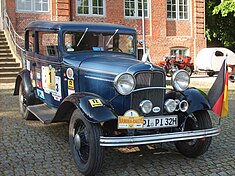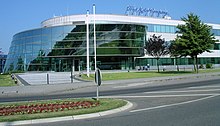
The Ford Taunus is a family car that was sold by Ford Germany throughout Europe. Models from 1970 onward were built on the same basic construction as the Ford Cortina MkIII in the United Kingdom, and later on, the two car models were essentially the same, differing almost only in the placement of the steering wheel. The model line was named after the Taunus mountain range in Germany, and was first made in 1939, and continued through several versions until 1994.
The automotive industry in the United Kingdom is now best known for premium and sports car marques including Aston Martin, Bentley, Caterham Cars, Daimler, Jaguar, Lagonda, Land Rover, Lister Cars, Lotus,MG, McLaren, Mini, MOKE, Morgan, Rolls-Royce and TVR. Volume car manufacturers with a major presence in the UK include Nissan, Toyota, BMW, and Vauxhall Motors. Commercial vehicle manufacturers active in the UK include Alexander Dennis, Dennis Eagle, IBC Vehicles, Leyland Trucks, TEVVA and London Electric Vehicle Company.

The Ford Köln is an automobile that was produced by Ford Germany from 1933 until 1936 at its Cologne plant.

The Ford Eifel is a car manufactured by Ford Germany between 1935 and 1940. It initially complemented, and then replaced, the Ford Köln. It was itself replaced by the Ford Taunus.

The Ford Transit is a family of light commercial vehicles manufactured by the Ford Motor Company since 1965, primarily as a cargo van, but also available in other configurations including a large passenger van, cutaway van chassis, and a pickup truck. The vehicle is also known as the Ford T-Series, a nomenclature shared with Ford's other light commercial vehicles, the Ford F-Series trucks, and the Ford E-Series chassis. As of 2015, 8 million Transit vans have been sold, making it the third best-selling van of all time and has been produced across four basic platform generations, with various "facelift" versions of each.

The Ford Sidevalve is a side valve from the British arm of the Ford Motor Company, often also referred to as the "English Sidevalve". The engine had its origins in the 1930s Ford Model Y, and was made in two sizes, 933 cc (56.9 cu in) or "8 HP", and 1,172 cc (71.5 cu in) or "10 HP". The early engines did not have a water pump as standard, instead relying on thermosiphon cooling as the Model T engine had. A water pump was added in 1953 for the 100E models when the engine was re-engineered to the point that few specifications are identical between the early and the later series. The Sidevalve engine was used in many smaller Fords as well as farm vehicles, commercial vehicles and a marine version in boats. Production of the engine was stopped in 1962. Windscreen wipers were often driven by the vacuum generated in the inlet manifold.
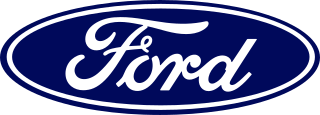
Ford France is the French subsidiary of the American automaker Ford Motor Company, which existed under various names between 1916 and 1954, when Ford sold the manufacturing business to Simca.
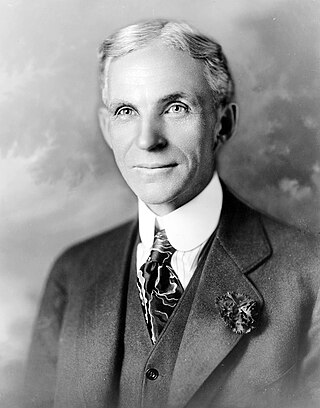
The Ford Motor Company is an American automaker, the world's fifth largest based on worldwide vehicle sales. Based in Dearborn, Michigan, a suburb of Detroit, it was founded by Henry Ford on June 16, 1903. Ford Motor Company would go on to become one of the largest and most profitable companies in the world. The largest family-controlled company in the world, the Ford Motor Company has been in continuous family control for over 110 years. Ford now encompasses two brands: Ford and Lincoln. Ford once owned 5 other luxury brands: Volvo, Land Rover, Jaguar, Aston Martin, and Mercury. Over time, those brands were sold to other companies and Mercury was discontinued.

Ford of Europe GmbH is a subsidiary company of Ford Motor Company founded in 1967 in Cork, Ireland, with headquarters in Cologne, Germany.

The automotive industry in Germany is one of the largest employers in the world, with a labor force of over 857,336 (2016) working in the industry.
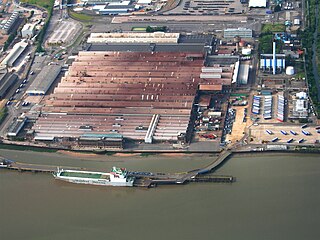
Ford Dagenham is a major automotive factory located in Dagenham, London, operated by the Ford of Britain subsidiary of Ford Motor Company. The plant opened in 1931 and has produced 10,980,368 cars and more than 39,000,000 engines in its history. It covers around 475 acres and has received over £800 million of capital investment since 2000.

The Ford Taunus G93A is a small family car that was produced by Ford Germany between 1939 and 1942 in succession to the Ford Eifel. It was the first car developed at Cologne by Ford Germany which previously had built cars originated by Ford businesses in the US or the UK. Production began on 30 April 1939, with the first car exhibited to the public in June 1939, less than six months before the outbreak of war in Europe.

The Ford Taunus P1 is a small family car which was produced by Ford Germany from 1952 until 1962. It was marketed as the Ford Taunus 12M, and, between 1955 and 1959, as the larger-engined Ford Taunus 15M. The company produced a succession of Ford Taunus 12M models until 1970, as the name was applied to a succession of similarly sized cars, but the first Taunus 12M models, based on the company's Taunus Project 1 (P1), remained in production only until 1962. In that year the Taunus P1 series was replaced by the Taunus P4 series.
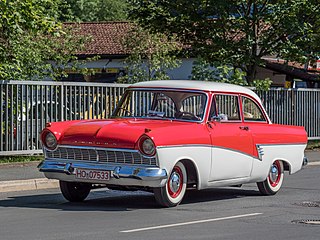
The Ford Taunus 17 M is a middle sized family saloon/sedan that was produced by Ford Germany between August 1957 and August 1960. The Taunus 17M name was also applied to subsequent Ford models which is why the car is usually identified, in retrospect, as the Ford Taunus P2. It was the second newly designed German Ford to be launched after the war and for this reason it was from inception known within the company as Ford Project 2 (P2) or the Ford Taunus P2.

The Ford Taunus 17 M is a middle sized family saloon/sedan that was produced by Ford Germany between September 1960 and August 1964. The Taunus 17M name had been applied to the car's predecessor and it would apply also to subsequent Ford models which is why the 17M introduced in 1960 is usually identified, in retrospect, as the Ford Taunus P3. It was the third newly designed German Ford to be launched after the war and for this reason it was from inception known within the company as Ford Project 3 (P3) or the Ford Taunus P3.

The Ford Taunus 12M is a small family car that was produced by Ford Germany between September 1962 and August 1966.
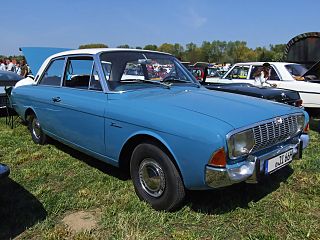
The Ford Taunus 17 M is a middle-weight family saloon/sedan that was produced by Ford Germany between 1964 and 1967. The entire range was first presented in September 1964 and volume production of the two and four door saloons/sedans began in November 1964. The "Turnier" version followed in January 1965 with coupé bodied cars coming along some time later.
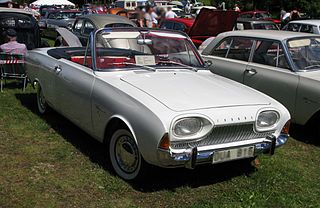
Karl Deutsch GmbH was a coach building firm known, in its later years, for converting mainstream motor cars into cabriolets. The business was located in Köln-Braunsfeld, a district on the west side of what today would be defined as central Cologne.

The Ford P7 is a range of large family saloons/sedans produced by Ford Germany between autumn 1967 and December 1971. The P7 was marketed as the Ford 17M, Ford 20M and Ford 26M.

The Ford Taunus TC is a range of large family cars that were built by Ford Germany from 1970 until 1982. The Taunus TC was based on the same basic construction as the Ford UK's Cortina range, with the "TC" badge standing for Taunus Cortina.



